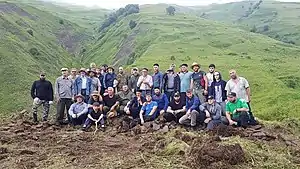Teip
Teip (also taip, teyp; Vaynakh тайпа taypa [ˈtajpə]: family, kin, clan, tribe[1]) is a Chechen and Ingush tribal organization or clan, self-identified through descent from a common ancestor or geographic location. It is a sub-unit of the tukkhum. There are about 150 Chechen teips. Teips played an important role in the socioeconomic life of the Chechen and Ingush peoples before and during the Middle Ages.
.jpg.webp)

Traditional teip rules and features
Common teip rules and some features:[2]
- The right of communal land tenure.
- Common revenge for murder of a teip member or insulting of the members of a teip.
- Unconditional exogamy.
- Election of a teip representative.
- Election of a headman.
- Election of a military leader in case of war.
- Open sessions of the Council of Elders.
- The right of the teip to depose its representatives.
- Representation of women by male relatives.
- The right of the adoption of outside people.
- The transfer of property of departed to members of the teip.
- The teip has a defined territory.
- The teip constructed a teip tower or another building or natural monument convenient as a shelter, e.g. a fortress.
- The teip had its own teip cemetery.
- The teip hospitality.
List of teips
Below is a list of teips with the tukkhum to which it may belong.
- Cheberloy tukkhum (Russian: Чебарлой);
- Sharoy tukkhum (Russian: Шарой);
- Shotoy tukkhum (Russian: Шотой);
- Ovkhoy tukkhum (Russian: Ауховцы, Овхой);
- Mälkhiy tukkhum (Russian: Мялхий);
- Nokhchmakhkakhoy tukkhum (Russian: Нохчмахкахой);
- Allaroy (Russian: Алларой);
- Belgatoy (Russian: Белгатой);
- Benoy (Russian: Беной);
- Biltoy (Russian: Билтой);
- Chartoy (Russian: Чартой);
- Chermoy (Russian: Чермой);
- Tsontaroy (Russian: Цонтарой);
- Elistanzhkhoy (Russian: Элистанжхой);
- Engnoy (Russian: Энганой);
- Ersenoy (Russian: Эрсеной);
- Gendargnoy (Russian: Гендаргеной);
- Gordaloy (Russian: Гордалой);
- Gunoy (Russian: Гуной);
- Kharachoy (Russian: Харачой);
- Yalkhoy (Russian: Ялхой);
- Zandkhoy (Russian: Зандкъой);
- Orstkhoi tukkhum (Russian: Орстхой);
- Chantiy tukkhum (Russian: Чантий);
- Chanti (Russian: Чанти);
- Tukkhum is not known / Without a Tukkhum;
- Chinkhoy (Russian: Чинахой);
- Dishni (Russian: Дишни);
- Marshaloy (Russian: Маршалой);
- Mulkoy (Russian: Мулкой);
- Nashkhoy (Russian: Нашхой);
- Peshkhoy (Russian: Пешхой);
- Satoy (Russian: Сатой);
- Turkoy (Russian: Туркой);
- Terloy tukkhum (Russian: Терлой);
- Khindkhoy (Russian: Хиндхой);
- Kalkhoy (Russian: Калхой);
- Yalkhoroy (Russian: Ялхорой);
- Zumsoy (Russian: Зумсой);
- Zurzakkhoy (Russian: Зурзакхой).
Identity, land and descent
Teips being sub-units of tukkhums, members of the same teip are traditionally thought to descend from a common ancestor, and thus are considered distant blood relatives. Tribal names were often derived from this ancestral founder.[3] As is also true of many other North Caucasian peoples, traditionally Chechen men were expected to know the names and places of origin of his ancestors on his father's side, going back many generations.[3] Many women also memorized this information, and keener individuals can often recite their maternal ancestral line as well.[3] The memorization of the information serves as a way to impute clan loyalty to younger generations.[3] Among Peoples of the Caucasus, traditionally, large scale land disputes could sometimes be solved with the help of mutual knowledge of whose ancestors resided where and when.[3]
A teip's ancestral land was thus held as sacred, because of its close link to teip identity. It was typically marked by clan symbols, including the clan cemetery, tower, and sanctuary.[3] Land being scarce in mountainous Chechnya, after the feudal system was overthrown, each teip claimed a definite area of land.[4] Land boundaries were marked by stones with specific marks pointing to a local place of worship.[4] While at first land was owned collectively, individual cultivation ultimately became the norm. [4] In old Chechen tradition, women were allowed to own land.[4] The vehement Chechen opposition to Soviet collectivization has been explained by the threat it posed to the traditional customs of land allotment.[4]
Political function
Each teip had an elected council of elders, a court of justice, and its own set of customs. The civilian chief, referred to as the thamda or kh'alkhancha, chaired the council of elders. The baechcha, meanwhile, was the military leader.[3]
Subdivisions
The teip has its own subdivisions, in order of their progressive nesting, the vaer, the gar, and the neqe. The neqe consists of households sharing the same family name, while the gar is a number of neqe units that together form a common lineage.[5] The basic social unit, meanwhile, was the household, consisting of the extended family spanning three or four generations, referred to as the ts'a or the dözal, with married daughters usually living with in the household of their spouse. Brothers would share the same land and livestock.[5]
Formation of new teips
The number of teips has been unstable in recent history. While there were 59 Chechen teips in the early 19th century, this swelled to a hundred by the mid-19th century, and today there are about 170.[3] New teips could be founded when a large gar broke off and claimed the title of a full-fledged teip.[5]
See also
References
- Нохчийн-Оьрсийн словарь (Chechen-Russian Dictionary, A.G. Matsiyev, Moscow, 1961), also available online: Чеченско-Русский словарь: “схьаIенадала-такхадала” Archived 2011-07-19 at the Wayback Machine; and Ингушско-Русский словарь (online Ingush-Russian dictionary) Archived 2012-08-17 at WebCite (in Russian)
- Traditional Social Organisation of Chechen people Archived 2011-07-19 at the Wayback Machine
- Amjad Jaimoukha. Nicholas Awde (ed.). The Chechens: A Handbook. p. 90.
- Amjad Jaimoukha. Nicholas Awde (ed.). The Chechens: A Handbook. p. 94.
- Amjad Jaimoukha. Nicholas Awde (ed.). The Chechens: A Handbook. p. 91.